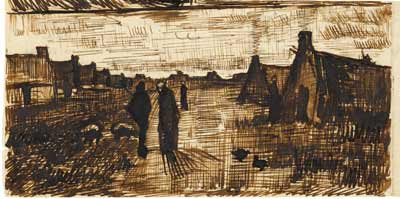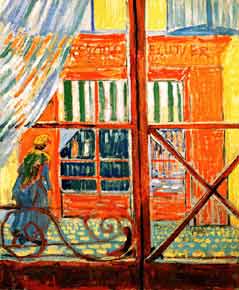Netherlands, (1853-1890)

-
Letter sketch – country road with cottages
- (1883), pen and ink (discoloured to brown) on cream colored machine-made wove paper
- 2.6 x 5.3 in. (6.5 x 13.5 cm.)
- Van Gogh Museum, Amsterdam
-
Editor’s Note:
Here is a close-up of the two pigs in this sketch.

Nieuw-Amsterdam is a village in the northeast Netherlands, in the Dutch province of Drenthe. In the Fall of 1883 Vincent Van Gogh stayed in the Scholte Boarding House in Nieuw-Amsterdam for two months while sketching and painting in the area.
The image above is one of six that Van Gogh included with a letter to his brother, Theo. This letter was written in Nieuw-Amsterdam on or about Wednesday, 3 October 1883. Here is an excerpt:
Flat planes or strips differing in colour, which grow narrower and narrower as they approach the horizon. Accentuated here and there by a sod hut or small farm or a few scrawny birches, poplars, oaks. Stacks of peat everywhere, and always barges sailing past with peat or bulrushes from the marshes. Here and there thin cows of a delicate colour, often sheep — pigs. The figures that now and then appear on the plain usually have great character, sometimes they’re really charming. I drew, among others, a woman in the barge with crepe around her cap brooches because she was in mourning, and later a mother with a small child — this one had a purple scarf around her head.
There are a lot of Ostade types among them, physiognomies that remind one of pigs or crows, but every so often there’s a little figure that’s like a lily among the thorns. In short, I’m very pleased about this trip, for I’m full of what I’ve seen.

-
A Pork Butcher’s Shop Seen from a Window,
Arles, February 1888 - (1888), oil on canvas on cardboard
- 15.6 x 12.8 in. (39.5 x 32.5 cm.)
- Rijksmuseum, Amersterdam
-
Editor’s Note:
A pork butcher in French is ‘charcutier’ and this term can be seen on the sign above the shop door.
Van Gogh was thirty-four years old in 1888 when he painted this. He wrote briefly about the town of Arles, France and this painting in a letter to his brother Theo, dated 25 February 1888. Here is an excerpt from http://www.webexhibits.org/vangogh/:
My dear Theo,
Thanks for your nice letter, also the 50’franc note.
So far I haven’t found life here as cheap as I’d hoped, but still I have three studies done, which probably I would not have been able to do in Paris these days…
The studies I’ve done are — an old Arlèsienne woman, a landscape with snow, a view of a bit of a pavement with a charcuterie [pork’butcher’s shop]. The women are quite beautiful here, that is no lie — but on the other hand the museum in Arles is atrocious and a joke, and ought to be in Tarascon. There is also a museum of genuine antiques here.
About the Artist
Vincent van Gogh, Netherlands, (1853-1890), was a Post-Impressionist artist. Initially he worked in somber colors, until he met Pissarro, Monet, Bernard, Gauguin and other Impressionists and Neo-Impressionists, in Paris. Then he began to lighten his very dark palette and to paint in shorter brushstrokes, eventually developing the brighter colors and painting style of the Impressionists into a uniquely personal and recognizable style of his own.
Van Gogh did not embark upon a career as an artist until 1880. He produced all of his more than 2,000 works — approximately 900 paintings and 1100 drawings and sketches — during the last ten years of his life. Most of his best-known works were produced in the final two years of his life, during which time he also cut off part of his left ear and suffered recurrent bouts of mental illness, finally committing suicide.
Van Gogh was a pioneer of what came to be known as Expressionism and had an enormous influence on 20th century art, especially on the Fauves and German Expressionists. [DES-4/07]
Additional information:
- The Van Gogh Museum and the Huygens Institute, have made available all Van Gogh’s letters to his brother Theo, as well as many to his artist friends Paul Gauguin and Emile Bernard, and many others. You can also check out Van Gogh’s letters at the WebExhibits online museum
